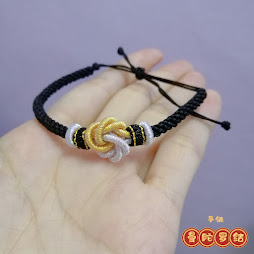与女“绳”结缘
名字:刘美君
鉴赏项目:中国结
语录:我想与你,与女“绳”结缘,好吗?
中国结的介绍(Introduction of Chinese Knot)
相信大家也了解过结绳记事,它在历史上也早有记载。从战国时期至唐宋时期,中国结开始慢慢被大量地运用于服饰和器物装饰中。古人尚玉,《尔雅义疏》中记载“佩玉之组条,用以连贯玉者,也叫纶,用丝绳婉转结之”。出土文物显示,早在战国时期,就已出现了众多种类的佩玉绳结。此外,古代的印章、铜镜大都有印钮、镜钮来系绳以便佩戴或手持。明清时期,中国结的发展达到鼎盛,出现各种用途、各种名称、各种样式的中国结,使中国结由一种装饰提升为一种艺术。
然而,从1949年中华人民共和国成立到1976年文化大革命结束,中国织结艺术在中国大陆几乎失传,但于港澳地区仍然有人视之为休闲嗜好,因此并未完全消失。直到在1970年代末,织结之风,才在台湾复兴。
如今,中国结的历史贯穿于人类史始终,漫长的文化沉淀使得中国结富含中华民族特有的丰富文化底蕴。人们已经把它重新定义为项链、手镯、耳坠、头饰、发夹等等的服饰配件及装饰品。
I believe everyone has learned about the
“knotting cords to record events”, and it has long been recorded in history.
From the Warring States Period to the Tang and Song Dynasties, Chinese knots
began to be used in a large number of clothing and utensil decorations. The
ancients admired jade, “Er Ya Yi Shu” recorded “Rope used to connect the jade,
also called Lun, tactfully knotted with silk rope." Unearthed cultural
relics show that as early as the Warring States period, many types of jade
knots had appeared. In addition, most of the ancient seals and bronze mirrors
have printed buttons and mirror buttons to tie ropes for wearing or holding.
During the Ming and Qing Dynasties, the development of Chinese knots reached
its peak, with various uses, various names and various styles of Chinese knots,
which promoted Chinese knots from decoration to art.
However, from the establishment of the People’s
Republic of China in 1949 to the end of the Cultural Revolution in 1976,
Chinese weaving knot art was almost lost in mainland China, but it is still
regarded as a leisure hobby in Hong Kong and Macau, so it has not completely
disappeared. It was not until the end of the 1970s that the Chinese weaving
knot art revived in Taiwan.
Nowadays, the history of the Chinese knot runs
through the history of mankind, and the long cultural precipitation makes the
Chinese knot rich in cultural heritage unique to the Chinese nation. People
have redefined it as clothing accessories and decorations such as necklaces,
bracelets, earrings, headdresses, hairpins and so on.
鉴赏与心得(Appreciation)
这次的鉴赏取名为与女“绳”结缘的原因是因为我想借助中国结来表达我对有缘人的祝福。
中国结不仅具有造型、色彩之美,而且皆因其形,意而得名,体现了中国古代的文化信仰,同时体现着人们追求真、善、美的良好的愿望。虽然制作中国结 所需的时间非常长,也非常容易因为小小的错误而必须拆掉重做,但是自己也能苦中作乐,把它尽全力的做好。
1. 祥云结
祥云指的是象征祥瑞的天气,寓意祥云绵绵、瑞气滔滔。再者,祥云结与舒展开来的云彩形似而得名。云彩,在中国古代传说一直都是神仙的坐骑,象征着祥瑞。在各种建筑物上,也能看到云彩雕刻和云彩图案的运用。
2.
吉祥结
吉祥结,寓意着吉祥如意、富贵、平安。吉祥结也常见于中国僧人的服装及庙堂的饰物上,是一个古老而又被视为吉祥的结式。
3.
曼陀罗结
曼陀罗结,寓意着诸事顺利、美满和谐、敬爱、天生的幸运儿、有着不止息的幸福、满载而归等等,具有扭转乾坤、带来好运的意思。
The reason for this
appreciation is named Get acquainted with the goddess "Rope" because
I want to use Chinese knots to express my blessings to those who are destined.
The Chinese knot not
only has the beauty of shape and colour but also got its name because of its
shape and meaning. It embodies the ancient Chinese cultural beliefs and at the
same time embodies people's good desire to pursue truth, goodness and beauty.
Although it takes a very long time to make a Chinese knot, and it is very easy
to dismantle and have to redo it because of small mistakes, but I can also have
fun while making it and do my best to do it well.
1. Auspicious Cloud Knot
Auspicious Cloud refers to the weather that
symbolises auspiciousness, and it implies auspicious clouds and a surging aura.
Moreover, the auspicious cloud knot and the unfolding cloud are named after it.
Clouds, in ancient Chinese legends, have always been the mounts of gods,
symbolising auspiciousness. Cloud carvings and cloud patterns can also be seen
on various buildings.
2. Auspicious knot
The auspicious knot means good luck, wealth and
peace. The auspicious knot is also commonly seen in the costumes of Chinese
monks and temple ornaments. It is an ancient knot that is regarded as
auspicious.
3. Mandala knot
The mandala knot implying that everything goes
smoothly, perfect harmony, respect and love, born lucky, endless happiness,
full return, etc. It has the meaning of turning things around and bringing good
luck.







感谢美君的分享!我手上还戴着你送的曼陀罗结手链。中国结的制作方式并不简单,尤其是错综的线条,缤纷的颜色,复杂的形状等都为其制作过程增添不少的难度。但这正好体现了中华艺术里“线的艺术”的美丽。而根据美君所言,中国结最早可以追溯到“结绳记事”,这就代表了这些结其实是承接了语言的寓意,是生活中不可缺少的、保存记忆的艺术。而根据美君的作品,吉祥结的中心就像个8个直线绳,分作4个方向,双双缠绕成方,而外围再由方的四个边中心延伸出圆,展现了中华民族字体的方圆,真不愧是寓意吉祥的中国结。
ReplyDelete羡煞旁人,真不愧是寓意吉祥的中国结。
Delete通过美君您的分享,让我连接起了中国结和早期结绳记事这两件事,属实让我有所感悟。一条线所牵起的不仅是一方对另一方的祝福,更多的是一条线所编的结代表着一个民族的内涵与思想,也是牵连起了整个中华民族的生活智慧结晶。通过美君同学的分享,我也着实看见了一个个心灵手巧、又承载着送礼人心意的 “结”,精美之余又更添寓意。
ReplyDelete美君同学你好。从小到大,接触最多的中华艺术便是中国结,它点缀过车、笔袋、钥匙等大大小小可以悬挂装饰品的物品。它深远的意蕴、吉祥的寓意,使得它在古装电视剧或小说中,也常作为信物出现。我一直觉得它既古典繁华,又清丽脱俗,矛盾却又不矛盾。其中之美,在于外形,更在于内涵。每一眼,都是不一样的美。同学以巧妙的双手,用一根线串连起炎黄子孙的文化,用一根线交织出炎黄子孙的祝愿。错综复杂,却结的意远。
ReplyDelete美君同学你好。我一直以来都非常喜欢中国结,空闲时候也会编制一些中国结。从你的分享中,我感受到了你对这门手艺的用心,作品都非常的精致!从曼陀罗结、吉祥结再到禅云结的完成真的太精美和心灵手巧了。每种结法都有它自己的含义,也传递了美好的寓意得与他人,体现出了中华文化信仰。
ReplyDeleteThis comment has been removed by the author.
ReplyDelete美君同学你好。在我中学时期有与朋友制作过中国结,然而并没仔细深入研究。通过你的讲解,我才了解到原来中国结有着不同的寓意。而制作中国结需付出较多的细心和耐心,只要一个步骤做错就有可能会出现“死结”或影响到整体美观,继而需重新做过。此外,因中国结有好寓意,我愿意和女“绳”结缘。希望将来能和你学习如何制作中国结,自用送礼都很合适。
ReplyDelete妳好美君同学!妳所制作的中国结都含有吉祥的意义在其中,也许这就是中国结的美妙之处,不只是外表华丽,同时蕴含着祝福的寓意。中国结看似简单,事实上并非如此,每个结的形成都需要经过一方的思考才能结成,而且还需要考虑颜色的搭配才能呈现出特定的意义。
ReplyDelete